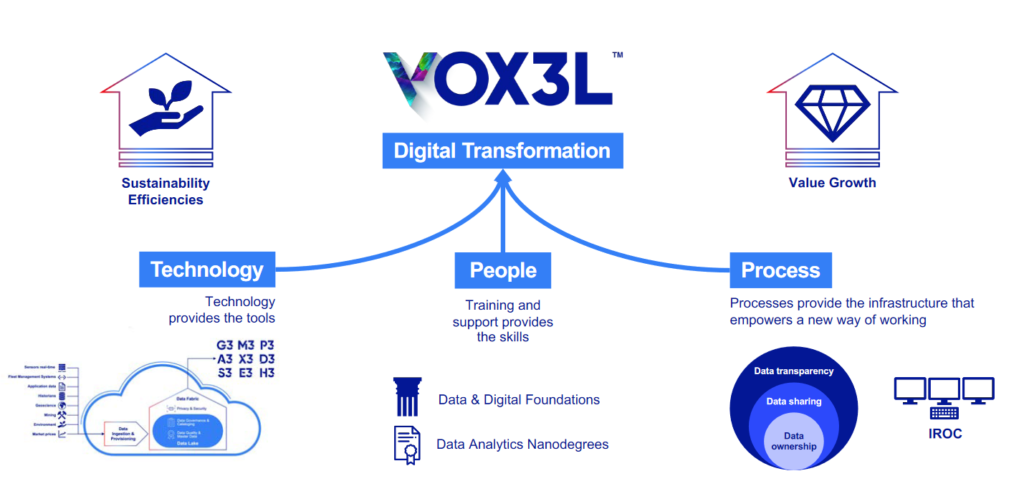Anglo’s Technology Update Summary

In May, Anglo American’s provided a technology update for its global operations which was presented by Tony O’Neill, the Group Technical Director. The presentation received some media attention but there was a lot of information to process which means some of the more interesting bits might have been missed
We have created a more comprehensive summary for our clients and readers. There is no doubt that Anglo is serious about transforming their business. If you read between the lines, you start to get a clear picture where the industry is going as I am sure many of these changes will be copied by other industry leaders.
Without further due, below is part one of our summary that provides a good overview of what Anglo American is doing to transform their business, what technology they are betting on, and how they are going about it.
Voxel – Data analytics

Some mining companies have chosen to outsource their digital transformation to accomplish their goals in this respect. Anglo has clearly chosen to go a different route which is to develop these capabilities internally.
Anglo’s digital transformation is underpinned by its proprietary Voxel software which uses Microsoft infrastructure although Anglo has full-stack IP ownership. The goal was to build an integrated end-to-end data solution that brought together every aspect of their business, which includes exploration, the mining processes, the processing of the final product, through to the logistics and delivery to customers.
The Voxel digitalisation platform is different than anything on the market because It was designed for mining not just equipment, it encompasses the full value chain and is not just focused on equipment health, it leverages technical and sustainability knowledge, and it includes digital twins of the entire value chain, rather than just a single asset. Voxel is already helping specialists to work remotely at Anglo’s new Integrated Remote Operations Centre which services the Los Bronces mine from Santiago.
Some examples of how it is being used –
- Rapid Resource Modelling – creating a digital version of the ground in which the miner operates to provide an ‘always right’ model of ore concentrations.
- Asset Maintenance Optimisation – ensuring that maintenance on assets is carried out with the least impact on costs and plans overall and in the long-term.
- Mine Planning – it is helping to optimise the plan to extract the required ore for the greatest value, with the least environmental impact, safely.
- Safety & Health – it can be used to detect patterns and optimise tactics that minimise safety risks and maximise healthy working practices.
- Processing Planning – optimise the plan to safely process the required ore for the greatest value, with the least impact.
P101 – Operational Excellence
P101 is a productivity program that includes initiatives focused on delivering industry leading performance and productivity across all the company’s key plant and equipment. There were a number of projects across its operations that at a positive operating affect for the company. Anglo has valued the tangible benefits over $2 billion in gross run rate improvement in 2020 vs a 2017 baseline.
- Tactical Mine Design – The goal was to plan the mine around the equipment and improved safety which would increase compliance with the mine plan. Anglo has stated that this initiative contributed to delivering >25% improvement in shovel productivity at some of its operations.
- Blasting Design – Anglo is using fragmentation models to improve fragmentation which results in better truck and shovel payloads and milling rates. The company said it has eliminated unproductive trim/buffer blasts, with a 20-50% reduction in the number of weekly blasts and approximately 50% improved shovel loading rates in trim/blast areas. In blasting practices, the company reported a 50% improvement in drill and blast execution vs plan, which was enabled via real-time, in-field digital platforms.
- Haul Road Digital Twins – The goal is to analyse and improve existing haul roads. At Mogalakwena, Anglo has seen a 23% reduction in haul cycle time; plus 40% improvement in truck average empty speeds on the main haul cycle. It will use these learnings when designing future haul roads.
- Processing – Anglo was able to use dynamic modeling that targeted process design upgrades to help with debottlenecking. For example, by reconfiguring the circuits of existing infrastructure, they were able to increase process efficiency which led to a 7% year on year increase in the Minas-Rio throughput rate.
- Remote Asset Monitoring – The goal is to allow the mine to anticipate maintenance and model the optimum times to shutdown assets. This has led to reduced blockages and improved plant stability and run time. For example, a 12% increase in weekly direct operating hours was achieved at the Moranbah coal complex in Australia.
Will Anglo’s success developing Voxel be the new industry norm?
I believe that will depend on the size of the company and their commitment to digital transformation. Some of the larger miners have went down that path of developing in-house and then changed course. At this stage, it is not 100% clear what Anglo’s success will mean for the industry as a whole. For medium size miners, it might be more difficult to do this on their own which means they will need to rely on suppliers and outside expertise. There are plenty of companies who have interesting solutions but there are still questions and doubts given the organization change that a true digital transformation requires.
- Are there solutions that cover the whole value chain?
- How are the solutions implemented across a whole organization or only a specific asset?
- How does the complexity of mining companies effect the implementation process and therefore the success rate?
How is data being used to drive better operating results?
Clearly, Anglo’s P101 initiative was successful in driving better results. There are already suppliers providing solutions to improve mining operations by using digital twins, better modeling, remote monitoring, etc. The roadblock at this stage is adoption by the mining companies. Some suppliers have been more successful than others but to improve results there needs to be a wider adoption at an industry level. Mining companies will need to be confident that there is a positive cost/benefit case when looking at these solutions. Suppliers will need to do a better job of demonstrating value and ensuring their commercial model fits. Lastly, once you know there are changes that can be made that will drive better operating results than you need to be able to lock those changes in so that they can duplicated quarter after quarter. That is easier said than in done, particularly in a complex environment such as a mining operation.
Check out our post next week where we outline their “Future Mining” initiative and the technology that Anglo is betting on to get them there.
Ax Legal is a legal and business advisory firm that works with foreign companies in Latin America. Our team of legal and commercial advisors have a distinguished track record of helping foreign technology and services companies to grow and operate in Latin America. Over the years, we have worked with starts up, mid-size businesses, and publicly listed companies. The one common factor that connects are clients is that they are leaders in their field, providing innovative technologies and services to the industrial sectors.
To better understand how we can support you in the Region, please contact Cody Mcfarlane at cmm@ax.legal
https://www.angloamerican.com/~/media/Files/A/Anglo-American-Group/PLC/media/presentations/2021pres/anglo-american-technical-and-innovation-update-2021.pdf
https://www.angloamerican.com/~/media/Files/A/Anglo-American-Group/PLC/media/presentations/2021pres/sustainability-by-design-futuresmart-mining-presentation.pdf



 Santiago
Santiago Sydney
Sydney Lima
Lima